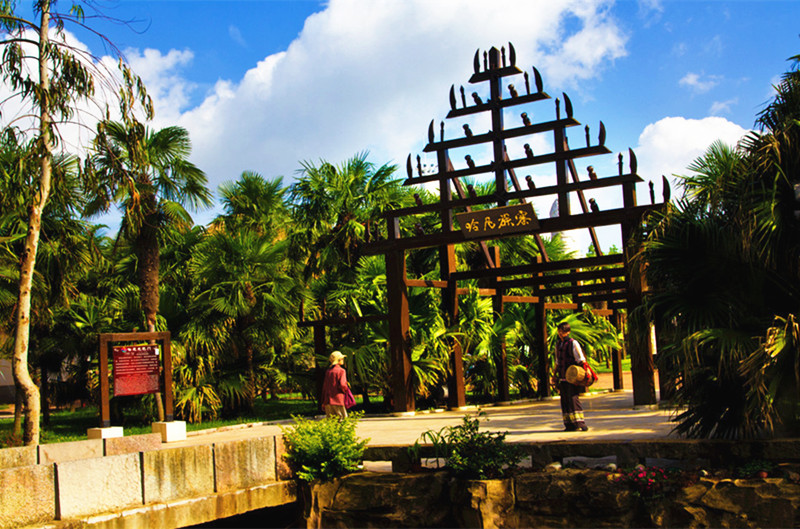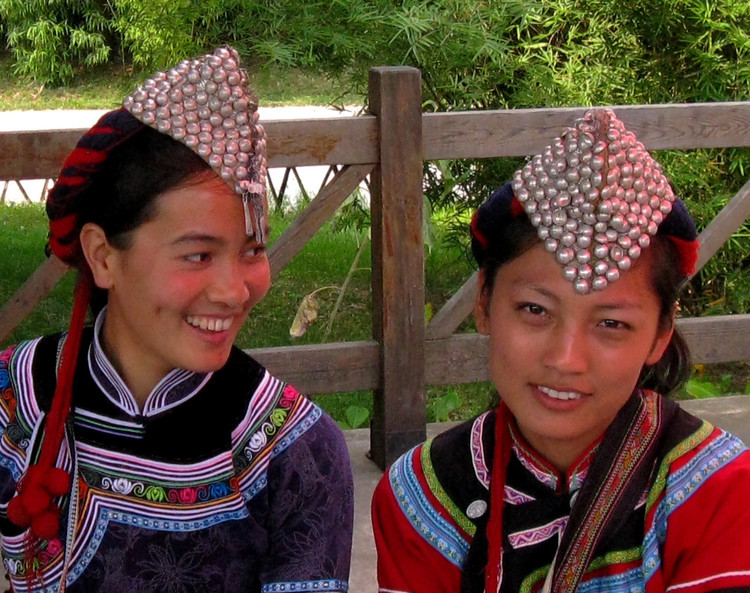
Village of Hani Ethnic Minority in Yunnan Ethnic Villages, Kunming
Overview
The Hani Village (哈尼寨) in Yunnan Ethnic Village covers 15 acres and showcases traditional Hani architecture and culture. Key features include:
- Mushroom Houses (蘑菇房): Typical residential structures with timber and earth construction, resembling mushrooms from a distance.
- Mother-Child Houses (爱尼母子房): Characterized by bamboo and wooden structures, where the main house is spacious, surrounded by smaller child houses.
- Sun and Moon Square (日月广场): A central area for gatherings and activities.
- Cultural Representations:
- A large relief sculpture illustrating the Hani legend of fish giving birth to all things.
- A totem pole depicting the migration legend of the Hani.
- Significant structures like the mill, Longba Gate (龙巴门), a swing area, and terraced fields (梯田).
- The ancestral tree (寨神树) and sacrificial stones (祭石) representing the Hani belief that “everything has a spirit” and their polytheistic worship.
Architecture
Hani architecture varies and can be categorized into four main styles:
- Eastern Tiled Houses (东瓦房)
- Earthen Houses (土掌)
- Southern Stilt Houses (南干栏)
- Thatched Houses (茅草房) in border areas
Mushroom Houses
- Structure: Typically multi-story, featuring stone foundations, earthen walls, and wooden columns.
- Roof Design: Built to withstand rain, facilitating food drying and preventing animal intrusion.
Mother-Child Houses
- Structure: The main house is spacious with an upper level for living and a lower level for livestock.
- Symbolism: Represents maternal affection and family unity, facilitating social interactions among youth.
Demographics
The Hani ethnic group (哈尼族) is a unique minority in Yunnan, with a population of approximately 1.65 million. Key points include:
- Geographic Distribution: Primarily found in the Three Rivers and Two Mountains region (三江两山地带), including the Honghe Hani and Yi Autonomous Prefecture (红河哈尼族彝族自治州). Other populations exist in Simao (思茅), Xishuangbanna (西双版纳), and Yuxi (玉溪).
- Cultural Relations: The Akha people (阿卡) in Laos and other regions are also related to the Hani.
- Language: The Hani have their own language but historically lacked a written script, with over 20 branches within the ethnic group.
Agricultural Practices
The Hani are renowned for their agricultural practices, particularly in rice cultivation:
- Historical Significance: They are considered one of the earliest ethnic groups to cultivate rice, abandoning traditional slash-and-burn methods for terraced farming.
- Terraced Fields: The Ailao Mountains (哀牢山) are home to numerous terraced fields, known for their dramatic beauty and agricultural innovation. The terraced fields in Yuanyang (元阳县) have become a cultural landscape.
Tea Cultivation
In addition to rice, the Hani are also among the first to cultivate tea:
- Oldest Cultivated Tea Tree: The “Shaguizhu” (沙桂茶), over 800 years old, grows in the Hani Mountain region in Banshan Village (半坡村) of Menghai County (勐海).
- Ecological Environment: The region’s ecological conditions are among the most suitable globally for tea cultivation, contributing to the Hani’s agricultural legacy.
Cultural Significance
The Hani Village in Yunnan Ethnic Village provides insight into the rich cultural heritage, architectural styles, agricultural practices, and historical significance of the Hani ethnic minority, highlighting their contributions to the region’s diversity and traditions.



 7 Days GolfingTour
7 Days GolfingTour
 8 Days Group Tour
8 Days Group Tour
 8 Days Yunnan Tour
8 Days Yunnan Tour
 7 Days Shangri La Hiking
7 Days Shangri La Hiking
 11 Days Yunnan Tour
11 Days Yunnan Tour
 6 Days Yuanyang Terraces
6 Days Yuanyang Terraces
 11 Days Yunnan Tour
11 Days Yunnan Tour
 8 Days South Yunnan
8 Days South Yunnan
 7 Days Tea Tour
7 Days Tea Tour
 8 Days Muslim Tour
8 Days Muslim Tour
 12 Days Self-Driving
12 Days Self-Driving
 4 Days Haba Climbing
4 Days Haba Climbing
 Tiger Leaping Gorge
Tiger Leaping Gorge
 Stone Forest
Stone Forest
 Yunnan-Tibet
Yunnan-Tibet
 Hani Rice Terraces
Hani Rice Terraces
 Kunming
Kunming
 Lijiang
Lijiang
 Shangri-la
Shangri-la
 Dali
Dali
 XishuangBanna
XishuangBanna
 Honghe
Honghe
 Kunming
Kunming
 Lijiang
Lijiang
 Shangri-la
Shangri-la
 Yuanyang Rice Terraces
Yuanyang Rice Terraces
 Nujiang
Nujiang
 XishuangBanna
XishuangBanna
 Spring City Golf
Spring City Golf
 Snow Mountain Golf
Snow Mountain Golf
 Stone Mountain Golf
Stone Mountain Golf
















